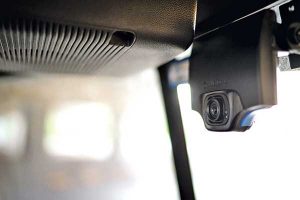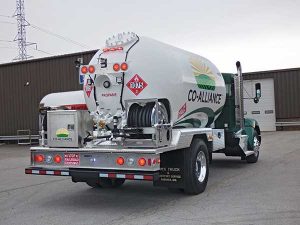How to better focus on driver safety
Del Lisk knows the answer to the question before he even asks it.
When speaking to various professional groups about driver safety, he’ll matter-of-factly ask those in the room who think they’re above-average drivers to raise their hand. Not surprisingly, every person in the room usually raises a hand.
With hands still raised, Lisk then asks a follow-up to the group. The question: Who here believes the people around you are above-average drivers? Immediately, all of those raised hands drop.
“When it comes to drivers who are professionals, they all think they’re very good drivers – and they may well be, but there is always room for improvement,” says Lisk, vice president of safety services at Lytx Inc., a San Diego-based company that specializes in video fleet management and fleet safety services.
As anyone who’s ever stepped behind the wheel can attest, the road is a dangerous place. And it’s not getting any safer, as a 2017 National Safety Council (NSC) report illustrates.

Lytx’s DriveCam system captures footage that can serve as a driver learning tool. Photo courtesy of Lytx Inc.
According to NSC, the number of motor vehicle deaths across the United States totaled 40,200 in 2016. That figure is up 6 percent from 2015 and up an astounding 14 percent since 2014. The 14 percent jump represents the largest two-year spike in more than five decades.
The NSC report also indicates that the estimated annual population death rate is 12.4 deaths for every 100,000 people, an increase of 5 percent from the rate of two years ago.
Such data should sober anyone who drives. Unfortunately, as retail propane companies well know, the road isn’t getting safer for their drivers. Certainly, propane drivers are at fault in some on-road instances. But because of the training drivers receive through commercial driver’s license (CDL) classes and often from their own companies and through other means, propane drivers are typically better prepared for the road than the average person who hops in his or her vehicle.
So, the biggest threat to propane drivers is, arguably, other drivers.
“Most drivers on the road are only concerned with their little bubble that surrounds their car, and they’re not paying attention to their surroundings,” says Matt Parsch, general manager of operations at Al Parsch Oil & Propane in Imlay City, Michigan. “This leaves not only propane but all big truck drivers the responsibility to be extra attentive while on the road.”
Creating a safer environment
So what’s a propane company to do when the safety of its drivers is partly in the hands of others?
There is no cure-all fix to the many challenges other drivers pose to propane drivers. Propane retailers can only control certain factors before they send their drivers onto the road. But some retailers have taken measures to enhance driver safety where they can.
Co-Alliance, a farm cooperative based in Avon, Indiana, for example, reevaluated its bobtail design within the last few years in an attempt to make its employees, customers and communities safer. Mike Hayden, the propane manager at Co-Alliance, heard all too often how other drivers tailing bobtails would be startled when bobtail drivers came to a stop at railroad crossings or at the end of customer driveways into which they planned to back.
To avoid sticky situations, Co-Alliance invested in more intense rear lighting that more clearly signals to trailing drivers when bobtails are coming to a stop.
“We have added much more lighting across the back of our trucks, high-mounted brake/turn lights in conjunction with strobe lighting to make sure we are seen,” says Hayden, who worked closely with BT&T (Bulk Truck & Transport Service Inc.) on the rear bobtail redesign. “We cannot change what other drivers are going to do, but we can avoid putting ourselves in dangerous situations.”
Co-Alliance bobtail drivers can even light up the back of their vehicle by simply flipping a switch.
“Four LED lights shine on that whole area,” Hayden says. “It makes drivers feel better and helps to avoid a problem.”
The challenges Co-Alliance drivers face are no different than those at other propane companies, he adds.
“We experience many other drivers who are determined to not follow our bobtails,” Hayden says. “We get passed on double yellow-lined roads, on bridges and even on the shoulder when stopping at railroad crossings. In those dangerous situations, we must slow down and give the aggressive drivers additional time and distance to avoid an accident.”
Co-Alliance has also gotten creative in how it routes drivers so they can increasingly avoid unsafe situations.
“Avoiding certain areas during peak congestion, turning right and not crossing highways are ways to keep everyone safer,” Hayden says.
Technology as a tool
The services Lisk’s company provides are designed to elevate on-road safety, as well. Lytx offers DriveCam, a technology built around video camera footage and supported by analytics of driver habits. The technology has been around for 19 years, Lisk says, but it has gotten “smarter” over the years because of collected data Lytx continuously incorporates into its program.

Lytx Inc. surveyed 1,357 attendees of its DriveCam Academy, composed of fleet managers and safety/risk professionals. According to Lytx, more than 60 percent of attendees assessed themselves as above-average drivers, while less than 10 percent believe others are above-average drivers. Click to enlarge.
As a propane bobtail utilizing the technology makes its way down a road, cameras continuously film inside the cab and the area in front of the moving truck. But, there’s a catch to the recordings Lytx captures: While cameras continuously record, only triggered events – a sharp braking, a swerve, an accident – are saved, evaluated and made available for a propane company’s use.
“There are accelerometers inside the device that measure changes in force,” Lisk says. “It also has a GPS, it’s measuring speed and there are a number of algorithms built into the device.”
Say a bobtail driver has to brake suddenly to avoid a deer. DriveCam will capture the event and indicate to the driver that it was captured through a flickering light in the cab. The captured video will then be uploaded to a Lytx human review center, which determines if a coachable behavior exists.
“In the example just described, that would be marked as near-collision and unavoidable,” Lisk says.
If, however, a potential risk does exist, then the clip is shared with the propane company.
“As those videos are reviewed and analyzed, it builds our database,” Lisk says. “We now have more than 70 billion driving miles of data that informs our algorithms.”
The DriveCam system has even evolved to sense when drivers are texting while driving.
“Our technology is continuously getting smarter, and it has the ability to sense a vehicle’s positioning in a lane,” Lisk says. “We know from looking at thousands of video clips of distracted drivers that they’ll drop off in speed and cross over lanes. Our camera is intelligent enough to trigger when those sorts of behaviors are identified. It’s continuously improving.”
Just having a camera in the cab will initially improve the behavior of most professional drivers, Lisk adds. After all, most professional drivers don’t want poor behaviors on the record.
Still, even propane drivers can resort to bad habits after a couple of weeks operating under the watchful eye of DriveCam, Lisk says. So it’s imperative that companies employing the system continuously look for opportunities to educate drivers about safety.
“When we analyze the different behaviors we see in videos, these are either issues of skill or will,” Lisk says. “By skill, we might have a driver who was simply following too close. That often is simply a behavior a driver doesn’t realize they do. But they’re setting themselves up for a big potential habit. So it’s just a matter of retraining.”
Also, footage proving another driver is at fault in the event of an accident can be valuable, he adds.
“If the video shows it was their fault, at least they know that and they can go solve the problem very quickly,” Lisk says. “But well over half the time it shows their driver is not at fault – and now they have the video to defend themselves.”
Yet, the problem remains

Co-Alliance added several features to the backs of its trucks, including more lighting and higher-mounted brake/turn lights, to enhance driver safety. Photo courtesy of Co-Alliance
Regularly incorporating safety into meeting discussions is yet another approach some propane retailers take to keep drivers safe.
“Our company has three safety trainings a year, and in every meeting, whether it’s the main topic or not, we cover driving in some fashion,” Parsch says. “I believe the more a driver is made aware of the risks and the more times he or she is given safe-practice information, the more likely they are to return home safe at the end of the day.”
Tim Lease, energy division manager at Premier Cooperative in Mount Horeb, Wisconsin, suggests retailers utilize Propane Education & Research Council (PERC)-provided training materials, including educational information related to bobtail rollovers.
“Also, remind your drivers to continue to drive defensively,” Lease says. “It’s a good idea to watch cross traffic carefully to make sure other drivers don’t blow a stop sign.”
These sorts of approaches to safety training are all worthy in that they can better propane drivers for the road. The fact remains, however, that a top obstacle – other drivers – is a very real problem.
Propane drivers can only do so much to protect themselves from others who insist on cutting them off or routinely put them in dangerous on-road situations. Law enforcement can only do so much, too, to mitigate poor driver behaviors.
So what’s the answer to move toward safer roads?
“If you want to reduce vehicular accidents, you have to make the training more stringent and you have to invest in highways,” says Stuart Flatow, vice president of safety and training at PERC.
Lease agrees the poor overall condition of U.S. roads and bridges contributes to a lack of on-road safety.
“There seem to be a lot more road hazards out there, from potholes to crumbling shoulders,” he says.
To Parsch, the state of on-road safety can be attributed to “the participation trophy effect,” which entitles everyone to the same fruits.
“When people are raised to believe they are good at things when they are not, they never really learn the skill or function they are trying to conquer,” he says. “This includes driving.”
More: Is it me or are the roads less safe?
Featured photo: iStock.com/samiylenko
















